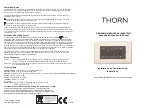
2-25
Cisco IE 3010 Switch Hardware Installation Guide
78-19581-01
Chapter 2 Switch Installation
Connecting Devices to the Ethernet Ports
Connecting Devices to the Ethernet Ports
•
Connecting to the 10/100 and 10/100/1000 Ports, page 2-25
•
Connecting to the 10/100 PoE Ports, page 2-26
Connecting to the 10/100 and 10/100/1000 Ports
The 10/100 and 10/100/1000 Ethernet ports use standard RJ-45 connectors with Ethernet pinouts. The
maximum cable length is 328 feet (100 meters). The 100BASE-TX and 1000BASE-T traffic requires
Category 5, Category 5e, or Category 6 UTP cable. The 10BASE-T traffic uses Category 3 or Category
4 cable.
The autonegotiation feature is enabled by default on the switch. At this setting, the switch ports
configure themselves to operate at the speed of the attached device. If the device does not support
autonegotiation, you can set the switch port speed and duplex parameters. To maximize performance,
either let the ports autonegotiate both speed and duplex, or set the port speed and duplex parameters on
both ends of the connection.
For simplified cabling, the automatic medium-dependent interface crossover (auto-MDIX) feature is
enabled by default. With auto-MDIX enabled, the switch detects the required cable type for copper
Ethernet connections and configures the interface accordingly. Therefore, you can use either a crossover
or a straight-through cable for connections to a 10/100/1000 Ethernet port, regardless of the type of
connected device.
See the switch software configuration guide or the switch command reference on Cisco.com for more
information about autonegotiation and auto-MDIX.
If auto-MDIX is disabled, use the guidelines in
Table 2-1
to select the cable for connecting the
10/100/1000 Ethernet ports to other devices. See the
“Connector and Cable Specifications” section on
page B-1
for cable-pinout descriptions. See
Figure 2-23
.
Figure 2-23
Connecting to an Ethernet Port
207211
















































